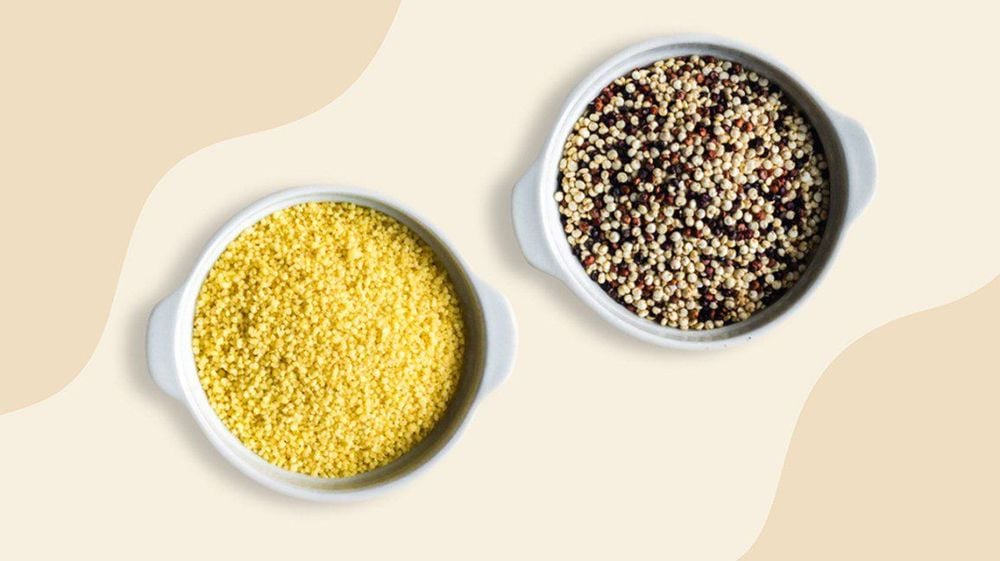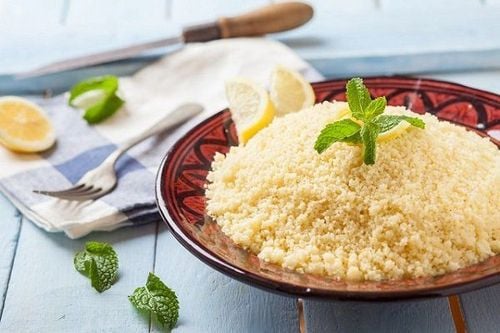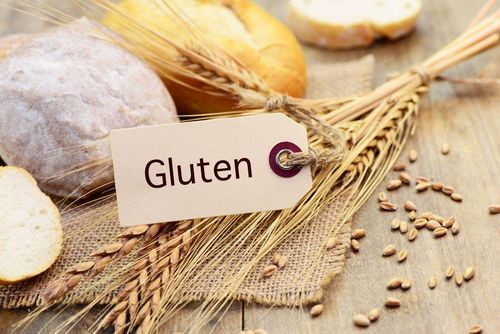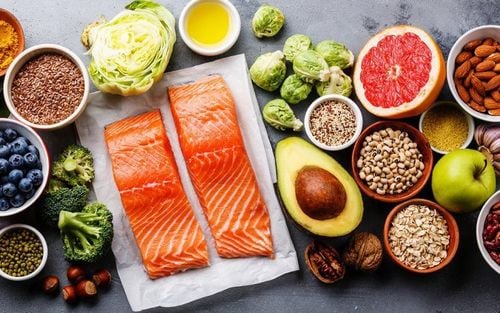Couscous and quinoa are both nutrient-rich foods that offer a variety of health benefits. However, quinoa is suitable for those following a gluten-free diet, while couscous contains gluten and therefore cannot be consumed by individuals in this group.
1. What are Couscous and Quinoa?
Couscous and quinoa have similar appearances but are two different foods.
Couscous is a type of pasta that looks like rice grains but is yellower in color. It is typically dried, packaged, and steamed or cooked like rice. This pasta belongs to the grass family (Gramineae) and is a staple food in North African countries, particularly Morocco, Algeria, and Tunisia.
Quinoa, also known as "the Andean grain", belongs to the Chenopodiaceae family. There are three main types of quinoa: red, black, and white. All of them are cultivated in the Andean region of South America, where the plant originates. However, quinoa is not classified as a cereal grain due to differences in plant species and nutritional composition.
2. Comparison of nutritional Components between Couscous and Quinoa
Couscous and quinoa are similar, but the main difference lies in their nutritional components. The table below compares the nutritional components of 100g of couscous and quinoa:
| Componets | Couscous | Quinoa |
| Calories | 112 | 120 |
| Carbohydrates | 23.2 | 21.3 |
| Fiber | 1.4g | 2.8g |
| Protein | 3.8 | 4.4 |
| Fat | 0.16 | 1.92 |
| Selenium | 50% hàm lượng hàng ngày (DV) | 5% DV |
| Manganese | 3.6% DV | 27.4% DV |
| Folate | 3,7% DV | 10,5% DV |
| Iron | 2,1% DV | 8,2% DV |
Both couscous and quinoa contain primarily carbohydrates and have a relatively high protein content. Both foods are rich in carbs and protein while being low in fat, but they differ in their respective amounts.
In terms of carbohydrates, quinoa contains twice the amount of carbs compared to couscous, which helps you feel fuller for longer after eating quinoa.
Regarding protein, the difference is not significant, but unlike couscous and many other grains, quinoa is known for being a high-quality protein source, providing all essential amino acids.
In terms of fat, both quinoa and couscous are low in fat, but quinoa contains 12 times the amount of fat found in couscous. Most of this fat is composed of heart-healthy fatty acids like omega-3 and omega-6.
Quinoa has a low glycemic index (GI) of 53, while couscous has a moderate GI of 65. A low GI allows for a gradual and steady increase in blood sugar levels, whereas a high GI can cause a rapid spike in blood sugar after consuming the food.

3. Health benefits of Couscous and Quinoa
Both couscous and quinoa offer a variety of health benefits.
The high selenium content in couscous helps support the immune system and thyroid function, while also reducing the risk of cardiovascular disease and some cancers.
Couscous also acts as a powerful antioxidant, helping against the harmful effects of free radicals, which are factors that contribute to early aging and the development of cancer.
Similarly, quinoa contains a significant amount of antioxidants (such as phenolic acids, flavonoids, and terpenoids) that help prevent diabetes, fight cancer, and reduce inflammation.
Quinoa is a low-GI food, which can help reduce the risk of cardiovascular disease and diabetes.
Couscous contains a significant amount of gluten (a type of protein primarily found in wheat, barley, and rye), making it unsuitable for individuals with celiac disease or gluten sensitivity.
In contrast, quinoa is naturally gluten-free but contains a group of proteins found in gluten called prolamins. According to an in vitro study, these proteins may cause symptoms in some people who are sensitive to them.
However, human studies have shown that individuals with celiac disease can tolerate up to 50g of quinoa per day without adverse effects. This makes quinoa a safe alternative for those following a gluten-free diet.
4. Flavor and preparation of Couscous and Quinoa
Couscous and quinoa differ in both flavor and texture.
Couscous has a neutral flavor, meaning it takes on the taste of the ingredients it is cooked with. In contrast, quinoa has a slightly nutty flavor. In terms of texture, couscous is soft, similar to pasta, while quinoa is crunchier.
Both couscous and quinoa absorb water completely, just like rice, without the need to drain it. In addition to regular water, you can use chicken broth or vegetable broth to cook couscous and quinoa, enhancing the flavor of the dish.
Quinoa and couscous can be used interchangeably in many recipes, as both can be enjoyed hot or cold and serve as side dishes or mixed into salads.
Quinoa can also be ground into flour and used in baking due to its starch properties, such as gelling, viscosity, and foaming. Additionally, it helps add extra nutrients to baked goods, including protein, fiber, and antioxidants. Furthermore, quinoa can be used to make soups, porridge, and both sweet and savory snacks.

5. Which is better to eat: Couscous or Quinoa?
Both couscous and quinoa are delicious, versatile, and easy to cook. They both offer numerous health benefits, including supporting the immune system, improving heart health, controlling blood sugar levels, and providing protection against certain types of cancer.
However, if you're looking to boost your nutrient intake, increase protein levels, or follow a gluten-free lifestyle, quinoa is the better choice. On the other hand, if you simply want to switch up your pasta or rice servings, couscous can be a great option to diversify your meals. Keep in mind that couscous is not suitable for those on a gluten-free diet.
To arrange an appointment, please call HOTLINE or make your reservation directly HERE. You may also download the MyVinmec app to schedule appointments faster and manage your reservations more conveniently.
To arrange an appointment, please call HOTLINE or make your reservation directly HERE. You may also download the MyVinmec app to schedule appointments faster and manage your reservations more conveniently.








